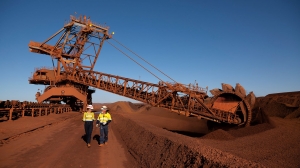


(Posted on 02/11/22)
Global miners BHP and Rio Tinto have formed a partnership agreement to accelerate the development of technology that could significantly increase water recovery from mine tailings, and in turn reduce potential safety risks and environmental footprints associated with tailings storage facilities.
The first project will involve testing the application of an innovative large-volume filter unit at a BHP copper mine in Chile, which would remove up to 80% of the water in the tailings stream before it is deposited in a storage facility.
Rio Tinto will bring its experience from implementing smaller-scale tailings filters for bauxite residues at alumina refineries since 2005. Both organisations will work in collaboration with leading technology and equipment providers, technical experts, research groups and the academic sector.
Manufacture of the filter unit is already underway. The pilot construction is due to begin in early 2023 and operations are scheduled to commence in early 2024. The pilot will test the potential of a large-scale tailings filter unit for scalability and cost-effectiveness across global mining operations.
Removing more water from tailings would reduce potential risks associated with moisture in storage facilities, reduce the footprint required by such facilities, and create opportunities to productively re-use tailings, for example, as raw material for glass, construction or agriculture industries.
The additional water recovered from tailings by filtration could be re-used in processing facilities, reducing overall water consumption.
BHP Chief Technical Officer, Laura Tyler, said: “The world will need more critical minerals in the decades to come to support economic development and decarbonisation pathways. It is important that we keep working together across the global mining sector to raise standards and make sure our operations are as safe and sustainable as they can be. Responsible management of tailings and improved water use is a big part of that.”
Rio Tinto Chief Technical Officer, Mark Davies, said: “It is in everyone’s interest that we, as an industry, find safer and more sustainable ways to manage tailings. As two of the leading companies in the sector, we want to bring our combined knowledge and expertise to address this challenge.”
Tailings usually takes the form of a liquid slurry made of fine metal or mineral particles and water – created when mined ore is crushed and finely ground in a milling process to enable the metals and minerals of interest to be extracted.
The National Grain and Feed Association (NGFA) has applauded Senator Deb. Fischer’s (R-Neb.) reintroduction... Read more
Anglo American plc and Teck Resources Limited have received regulatory approval from the Government... Read more
The Rhodes Ridge Joint Venture has approved a $191 million (A$294 million) (Rio Tinto share $96 million... Read more
Trafigura Group Pte Ltd, a global leader in the commodities industry, has announced its financial results... Read more
Rio Tinto has successfully produced the first copper from the Johnson Camp mine in Arizona using its... Read more
The American Soybean Association’s World Initiative for Soy in Human Health programme and the... Read more
Karlka Nyiyaparli Aboriginal Corporation (KNAC) Registered Native Title Body Corporate and Rio Tinto... Read more
OCI Global, a leading global producer and distributor of nitrogen products has announced that it has... Read more
In December 2024, SSAB was granted a permit by the Land and Environment Court at Umeå District... Read more
The President of the Republic of Guinea has joined project partners WCS1, Baowu, Chinalco and Rio Tinto... Read more